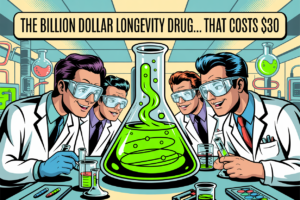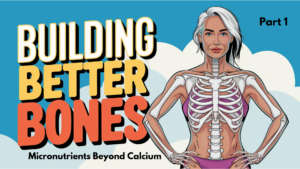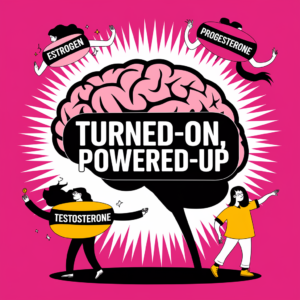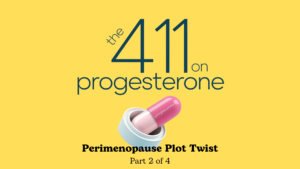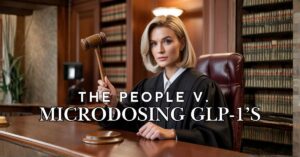While everyone’s busy doom-scrolling through political hot takes (seriously, it’s gloomy as hell out there!), Chinese scientists just casually figured out how to reverse aging in monkeys (Cell, 2025). But before we get to that atomic bomb of a teaser, we need to talk about the workplace mutiny happening inside your body right now.
No, I’m not talking about your actual job, I’m talking about something more insidious: cellular senescence. Think of it as your body’s version of that coworker who checked out mentally six months ago but somehow still shows up to the office every day, takes up space, complains constantly, and makes everyone else miserable.
Meet Your Bodies Worst Employees
Imagine that your body is a bustling corporation, and your cells are the employees. In a healthy company, workers show up, do their jobs, and when they’re past their prime, they gracefully retire (die off) to make room for fresh talent. But senescent cells? They’re Bitter Betty – the middle manager who refuses to quit, can’t do her job anymore, but spends all day spreading toxic gossip and making everyone else’s life harder.
These cellular Bitter Bettys have basically three career paths:
- The Burnout: They’ve hit their replication limit (like a copy machine that’s finally given up after 50,000 pages)
- The Stress Case: Environmental damage from UV rays, pollution, or oxidative stress has broken their DNA beyond repair
- The Failed Promotion: They were heading toward cancer but got stopped mid-transformation, leaving them stuck in biological limbo
These problem employees don’t just sit there quietly collecting a paycheck. They actively sabotage the workplace by releasing inflammatory chemicals called SASP (Senescence-Associated Secretory Phenotype). It’s like Bitter Betty started her own toxic MLM scheme inside your body – she’s not just unproductive, she’s actively recruiting healthy cells into her downline of dysfunction. Every inflammatory signal she pumps out is another of those manipulative ‘Hey Babe!’ messages, convincing neighboring cells to join her miserable pyramid scheme.
Where the Bitter Betty Brigade Hits Women the Hardest

Cellular senescence is one of the twelve recognized “Hallmarks of Aging,” and it has systemic effects, but specific systems are particularly affected in women. Like… WAMM BAMM No-Thank-You Ma’am!
Your Ovaries: Cellular senescence is a fundamental driver of ovarian aging, directly contributing to the decline in ovarian reserve, diminished egg quality, and eventual menopause. In fact, the ongoing VIBRANT study from Columbia is investigating whether the drug rapamycin, a potent senolytic, can slow ovarian aging. Check out my previous Substack, “Can We Slow Ovarian Aging” to learn more.
And remember, this isn’t just about fertility – it’s about losing the protective effects of estrogen and progesterone throughout your entire body. Your ovaries are going full Bitter Betty, removing your cellular bodyguards, leaving every other organ system more vulnerable to not just the effects of senescence but the effects of different drivers of aging (like mitochondrial dysfunction, inflammation, and stem cell exhaustion).
Your Skin and Hair: Remember when your face looked good even in unforgiving light, and you scoffed at those crazy women getting Botox and fillers because you simply couldn’t imagine what it would be like not to look fresh and fabulous? Senescent fibroblasts are why that party ended. These cellular Bettys stop producing collagen and elastin while simultaneously releasing enzymes that actively break down what you have left.
Your hair follicles aren’t immune to this cellular workplace drama either. Bitter Bettys accumulate around hair follicles, disrupting the stem cells responsible for hair growth and regeneration. This leads to hair that’s not just thinner, but also weaker, more brittle, and slower to grow.
Your Bones and Joints: Estrogen keeps bone cells happy and functional, and when it disappears at menopause, your bone cells become more susceptible to joining Betty’s club. Meanwhile, these disgruntled bone cells release inflammatory signals that actually recruit more cells to join their complaining circle (hello osteoporosis!). It’s Betty’s biological MLM in action – each newly senescent cell becomes another ‘boss babe’ spreading the toxic message and building their own downline of disaster underneath them.
Your Immune System: Your immune system is supposed to be the HR department that fires problem employees like Bitter Betty. However, as you age, immune cells themselves begin to act like Betty! They also become senescent (a process known as immunosenescence).
This creates a vicious cycle: more Bitter Bettys accumulate because fewer immune cells are doing their cleanup job, while the Bettys pump out inflammatory signals that further exhaust your immune system. It’s why you start getting sick more often, take longer to recover, and why I have a mountain biking “road rash” on my shin that still hasn’t healed, three weeks later!
The Great Monkey Breakthrough
Now, back to those Chinese scientists who just casually bent the aging curve. Published in Cell, Sept 2025, researchers developed a type of stem cell called SRCs (senescent-resilient human mesenchymal progenitor cells) through a gene-editing process. Then they injected them into macaque monkeys, which were equivalent to humans in their 60s and 70s. Over 44 weeks, these enhanced stem cells not only halted aging, they reversed it.
They showed deceleration of biological aging across 10 major body systems by an average of 3.34 years.
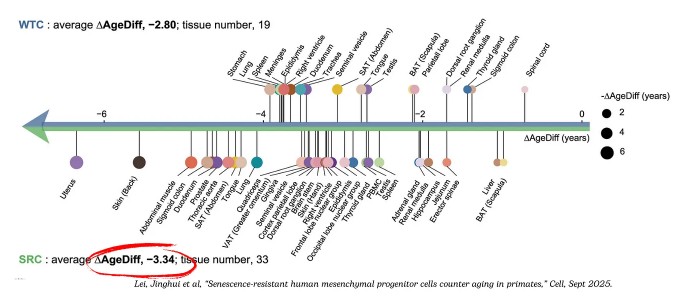
Fighting Back: Your Anti-Betty Action Plan
The good news? While those supercharged SRC’s aren’t yet ready for human deployment, you’re not helpless in this cellular workplace drama. Here’s your survival guide:
Lifestyle Interventions:
You don’t need to overhaul your life to start feeling better. You need smart, targeted steps rooted in research and clinical results. Here’s where to begin.
A. Restore Your Gut Microbiome
Move Your Body: Exercise is like hiring a professional cleanup crew for your cellular workplace. Regular moderate activity reduces senescent cell markers in your fat tissue, muscles, blood vessels, and even your colon. It’s one of the few things with solid human data showing it works.
Fast Strategically: Time-restricted eating (TRE) and caloric restriction are like mandatory company-wide layoffs, forcing your body to clean house and eliminate the dead weight. Bonus: Eat a diet rich in polyphenols, prebiotics and probiotics, which also promote anti-senescence efforts.
Sleep Like Your Life Depends on It: Because it does. Sleep deprivation increases senescence markers in both human and animal studies. Your immune system does its best Betty-clearing work while you’re unconscious. Lights out and the cleanup begins!

Supplements and Medications That MIGHT Help
Fisetin, found in strawberries and apples, is showing promising anti-senescence potential. Animal studies are impressive, and human trials are ongoing. Yum yum!
Quercetin: This onion-derived compound, especially when paired with Dasatinib (a cancer drug), has shown promise in small human studies for clearing senescent cells in kidney disease and lung fibrosis.
EGCG: This green tea extract suppresses pathways supporting senescent cell survival. Most evidence is in animals.
Rapamycin (sirolimus): Rapamycin suppresses the mTOR pathway. Think of mTOR as Betty’s megaphone. By turning down the volume on that megaphone, rapamycin muzzles Betty’s ability to spread inflammatory gossip (SASP) throughout your cellular office. She’s still there, but she can’t recruit other employees to join her Sad-Sacks club or steal everyone’s metabolic lunch money.
The results from animal studies with rapamycin are genuinely remarkable. Mice on rapamycin live longer, get fewer age-related diseases, maintain better immune function, and show reduced markers of cellular senescence. Human studies are still emerging, but early results suggest that rapamycin is safe at low, intermittent doses in older adults.
The catch? It’s a prescription-only medication. The most common dosing for rapamycin “off label” for longevity purposes ranges from 2-6+ mg per week, but it requires close supervision by your doctor. This is not a DIY management solution.
Metformin: This prescription diabetes drug has been around for a long time, but in recent years, it’s been evaluated for its potential as a “longevity drug.” Metformin acts on several protein complexes, and emerging evidence explores its role in aging and modulation of cellular senescence. It’s one to watch, but certainly isn’t for everyone.
The OS-01 Peptide by One Skin: I’ve been following OneSkin for years, and what’s impressed me most is how much they lead with the science. When they began in 2016, OneSkin’s researchers screened more than 900 peptides predicted to have senotherapeutic potential, narrowing down the selection to the most promising candidates through testing on real human skin samples. This led them to develop the OS-01 peptide.
OS-01 peptide, the key ingredient in their skin and hair topical products, consistently reduced the senescent cell burden while enhancing markers of skin and hair health in studies, including increased epidermal thickness, support for cellular repair pathways, promotion of collagen and hyaluronic acid production, and an increase in the number and quality of hair follicles.
The Bottom Line
Cellular senescence isn’t just some abstract scientific concept – it’s a big contributor to changes in your skin, joints, energy, and resilience. The Chinese monkey study suggests we might eventually have pharmaceutical solutions that can reverse this process systemically, but we’re not powerless while we wait.
Strategic lifestyle interventions, targeted supplements, and innovative topical treatments give us multiple ways to shut down Betty’s toxic operation. Your future self will thank you for dismantling this cellular pyramid scheme now, rather than letting Betty’s downline completely crash your body’s economy.
Trust me, corporate restructuring gets a lot messier when the toxic employees have been running the show for decades.
Share your thoughts, stories, or questions below.


